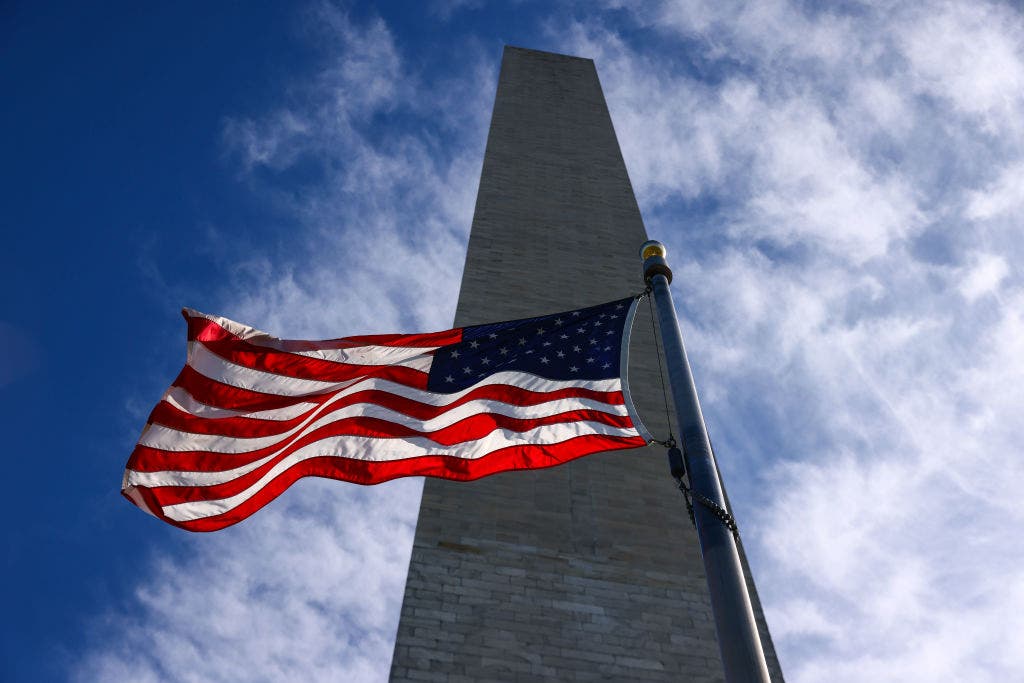The Washington Monument in Washington, D.C., which opened to the public on October 9, 1888, is a marble-faced granite obelisk that stands out as the most prominent feature of the city’s skyline. Standing at 555’ 5 1/8″ tall and weighing 81,120 tons, the monument honors the first U.S. president, George Washington. Built in two phases in 1848 and 1884, the structure is comprised of white marble blocks ranging from 15’ at the base to 18″ at the top. Visitors can climb the 896 steps inside the monument to reach the observation level or utilize the elevator. The construction of the monument faced delays due to controversy and a lack of funds, taking nearly four decades to complete in the mid-19th century.
The inception of the plans for the Washington Monument began in 1835 when The Washington National Monument Society was established to collect funds for the construction of a monument in honor of George Washington. Designed by Robert Mills, the cornerstone of the monument was laid on July 4, 1848, in a ceremony attended by 20,000 people, including President James K. Polk and future presidents James Buchanan, Andrew Johnson, and Abraham Lincoln. Despite early setbacks, the construction continued, with Congress allocating $2 million in federal funds in August 1876 to complete the project. Thomas Lincoln Casey was appointed as the engineer-in-charge, and by February 1880, contractors had begun installing staircase and elevator frames within the monument. The capstone and aluminum point were finally set on December 6, 1884, marking the completion of the construction.
After a major restoration project in the 1990s, the Washington Monument reopened to the public in 2001, allowing visitors to ascend to the top via elevator or nearly 900 steps. Surrounding the monument are 50 American flags, one for each state, symbolizing unity and patriotism. The monument also features a small museum at the top and panoramic views of the nation’s capital. Despite being closed temporarily due to an earthquake in August 2011, the monument reopened in May 2014, providing visitors with the opportunity to reserve a place online for a journey to the top. The Washington Monument remains an iconic symbol of the capital, offering a glimpse into the history and legacy of George Washington.
The Washington Monument’s construction had a lengthy and tumultuous history, with the plans originating in 1833 to honor George Washington’s 100th birthday. The monument’s design by Robert Mills was adopted by The Washington National Monument Society in 1845, leading to the laying of the cornerstone in 1848. However, it faced setbacks, including a halt in construction between 1856 and 1876 due to financial difficulties. Ultimately, with the aid of federal funding and the dedication of individuals like Thomas Lincoln Casey, the monument was completed after nearly 40 years of construction. The Washington Monument stands as a testament to the enduring legacy of George Washington and the perseverance of those involved in its creation.
Today, the Washington Monument continues to attract visitors from around the world, offering a unique perspective on the history and significance of the nation’s capital. The monument’s reopening in 2001 after restoration work and subsequent closure due to an earthquake highlights the ongoing efforts to preserve this iconic structure. Visitors can explore the museum at the top of the monument, take in the panoramic views of Washington, D.C., and appreciate the symbolism of the 50 American flags that surround the monument. Whether climbing the stairs or riding the elevator, visitors can experience a sense of awe and reverence for the history and architecture embodied by the Washington Monument. Historian John Steele Gordon describes it as the ultimate symbol of the capital, visible from every corner of Washington and representing the enduring legacy of George Washington and the United States as a whole.













